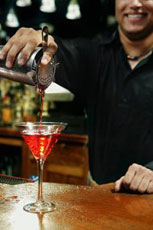Bartending: Shake and Ache

When you find yourself among a group of people of the same profession, a few common questions always arise. Salesmen will ask “how many sales do you average a month?” and lawyers always want to know “what firm do you work with?” The same is true with bartenders and mixologists. Being a part of many conversations with bartenders, it seems after the initial “where do you work” and “how long”, comes the question of “do you get these aches too..?”
Anyone who has ever watched a mixologist or a bartender shake up a cocktail or work behind the bar, can see that the physical movements along with intensely packed hours can take its toll. The repeated back and forth movement while using a cocktail shaker can become arduous. It is this repetitive motion, hour after hour, night after night, that adds aches and stiffens the muscles of the upper body. In addition to this seemingly harmless movement is the hours of standing, pouring bottles, and leaning all around the countertop.
It’s easy to argue as a professional how the speed versus the thrust, or the twist or roll, all effect the mix of the cocktail; but there is a price to pay. These days the bigger-than-average ice cubes are used and even though they chill drinks faster and delay the diluting of the drink, they make for a heavier mixer. Shaking up the perfect drink can also serve you a side of tennis elbow or a knotted forearm. Although many of these things are present and almost expected between the professionals, there are things that can be done to help make it a more comfortable night of work.
Here are some tips:
Pay attention to your body when using a shaker. Having the correct form is very important, not just in the way you shake the drinks, but also the way you stand. Good posture puts less stress on the back, helping to ease fatigue and pain. When shaking, use only the arms, and keep the back firm by flexing the abdominal muscles or very lightly bending your knees. By flexing the core muscles, you simultaneously support the back muscles. Try to keep your balance on both legs, rather than leaning on one leg, as this can misalign the spine and cause long-term pain as well as short-term discomfort. The constant leaning forward on the bar and bending down to pick up drinks can cause significant lower back pain over time as well. Take momentary breaks to do little stretches and relax these muscles. As simple as this sounds, remember to breathe through your diaphragm to deliver enough oxygen through your blood.
Having the right ergonomics is also very helpful. Consider asking to have anti-fatigue matting put behind the bar. These mats work by encouraging subtle movements of the leg muscles by causing them to contract and relax, as opposed to staying static. This helps the blood and oxygen to circulate through the legs and back to the heart, reducing fatigue and increasing productivity. Another good idea is to wear shoes with good support, or put good inserts in shoes you already own.
Every job comes with a downside and in this case it’s the accumulation of the seemingly small physical demands of a fast-paced job. Taking care of yourself and making small adjustments will help you feel better; and when you feel your best, you will stay on top of your game all throughout the night.
